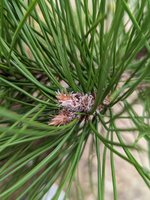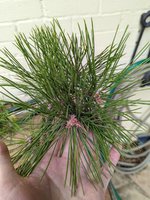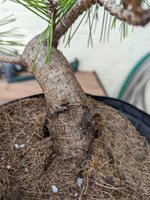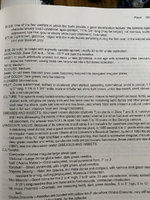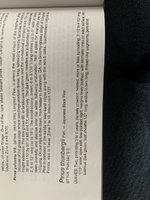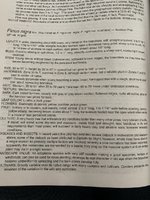You are using an out of date browser. It may not display this or other websites correctly.
You should upgrade or use an alternative browser.
You should upgrade or use an alternative browser.
Help ID This Pine
- Thread starter Apex37
- Start date
-
- Tags
- pine pine bonsai pine id tree id
Colorado
Masterpiece
What’s the trees history? Did it come from a bonsai nursery, landscape nursery, somewhere else? Very tough to ID from just a couple photos alone.
Crazy Diamond
Omono
Reminds me of Austrian pine or JBP but idk
Apex37
Chumono
I bought it from an online seller who had it for awhile. He lost the label and has a lot of trees, but was pretty sure it was a JPB. It honestly might be, just wanted to ask here and see.What’s the trees history? Did it come from a bonsai nursery, landscape nursery, somewhere else? Very tough to ID from just a couple photos alone.
Frozentreehugger
Masterpiece
Step one it’s a 2 needle pine step 2 think it’s a black pine so most common would be JBP and Austrian pine . The 3 pics are from Dirrs book for identification read the leaves and bud part carefully the trees are very similar I only have. A few very going JBP but grow Austrian Pinus nigra because seeds are easy to get for me and it’s more cold hardy in Canada the 2 trees are hard to tell apart in a pic like yours but the colour of the leaves amount of curveature in leaves and abundance crowded leaves leans me towards JBP Austrian leaves are darker than JBP but someone with more JBP experience may be bettter to ask
Attachments
Frozentreehugger
Masterpiece
Pics are in wrong order first pic is continuation or next page of second pick fir JBP
Shibui
Imperial Masterpiece
Reddish buds do not look like JBP. Smooth bark also unlike JBP unless this is very young. Needles also appear too long and thin for JBP.
Not really enough to make a good ID but I doubt this is JBP.
Not really enough to make a good ID but I doubt this is JBP.
Ryceman3
Shohin
It’s not JBP. The buds are completely different. I also doubt it’s Austrian Black Pine looking at your bud picture. It has relatively long and slender needles… with that in mind (and the bud pic) my guess is Japanese Red Pine. The bark is too young to really help ID from.
Frozentreehugger
Masterpiece
Conversation getting interesting I don’t have Japanese red pine. Dirr says bark is reddish orange. At a young age true if North American red pine also scots pine takes longer to red but the leaves look all wrong think we need better pics and info of location example I grow Austrian pine from local trees planted here in Canada I’ve seen trees grown in warner climates that are very different in bark and leaf colour
Apex37
Chumono
Well, if it's not JBP I guess my worry becomes if it will survive here in 8a.
Shogun610
Masterpiece
JRP
Frozentreehugger
Masterpiece
Good point did not notice where Austrian black limit z7 same as JRP 3 to 7Well, if it's not JBP I guess my worry becomes if it will survive here in 8a.
Shibui
Imperial Masterpiece
JBP and JRP are known to hybridize where trees are growing close enough so that could be another possible ID.
The reddish buds and longer needles do look somewhat like red pine. Bark is probably too young to get any clues from the trunk.
The reddish buds and longer needles do look somewhat like red pine. Bark is probably too young to get any clues from the trunk.
Frozentreehugger
Masterpiece
Interesting about the hybrid did not know that . Red bud makes JRP about the only red pine option some others are reddish brown like I said have no JRP experience but it apparently red bark at a very young age what other warm climate 2 needle pines are there not a lot around here there is still snow outside 

Shibui
Imperial Masterpiece
A few of my JRPs are close to 25 years now but I would not describe bark as red or even slightly reddish.
I cannot help with cold resistance of pines as I live in a much warmer environment. Maybe some others can help with cold resistance?
I cannot help with cold resistance of pines as I live in a much warmer environment. Maybe some others can help with cold resistance?
Frozentreehugger
Masterpiece
The pine owner lives in Texas warm climate the cold climate reference was where I live in Canada hence I have no experience with warm climate trees
Potawatomi13
Imperial Masterpiece
"Hairy" buds look as Italian red/Italian stone pine. Have not seen another like this .
.
Leo in N E Illinois
The Professor
- Messages
- 11,425
- Reaction score
- 23,592
- USDA Zone
- 5b
All of the pine species of Pinus subsection Pinus which includes P. thunbergii, resinosa, densiflora, nigra, mugo and others for a total 19 species plus all 7 species of the subsection Pineaster, which includes Pinus pinea and halepensis all have 2 needles. All would thrive just fine in Texas. There are an additional half dozen 2 needle pines from other subsections of the Pinus genus, so the list of suspects is long.
Better photos of the buds, taken from the side would help. It might not be possible to really sort out just which pine this is until it is old enough to produce a pine cone or two, as the arrangement of prickles on the scales of the pine cones is diagnostic to species.
So one can guess, but until the tree produces cones, one might not know for certain.
Better photos of the buds, taken from the side would help. It might not be possible to really sort out just which pine this is until it is old enough to produce a pine cone or two, as the arrangement of prickles on the scales of the pine cones is diagnostic to species.
So one can guess, but until the tree produces cones, one might not know for certain.
Frozentreehugger
Masterpiece
As bonsai practitioners one of the main advantages we have is the tree is in a pot so it’s mobile and we can use that . To alter its growing environment . That being said the majority of pines including 2 needle pines native range is the colder regions of the planet . I would not advice someone they all can grow in Texas while anything is possible with enough effort there is difficulty raising trees outside there recommended range. I would not
Discourage anyone from trying anything new that is not the same as recommend something . With the possibility of failure being higher not having a good motivation to people to continue in the past time . As for identification there is a wealth of info available Dirrs book for example that can identify a tree based on observation of foliage stems buds bark and broth habit even identifying a cross between 2 other plants
Discourage anyone from trying anything new that is not the same as recommend something . With the possibility of failure being higher not having a good motivation to people to continue in the past time . As for identification there is a wealth of info available Dirrs book for example that can identify a tree based on observation of foliage stems buds bark and broth habit even identifying a cross between 2 other plants
Eckhoffw
Masterpiece
Waxy buds look Mugo to me. However I know little about pines. 

